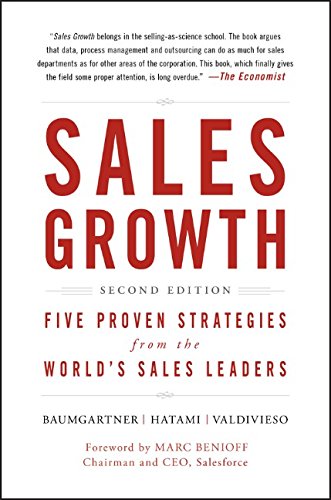INSIDER: Sales Growth
Erick Huntley, MBA
 From advances in technology to globalization to customer knowledge expertise, the sales world is always changing. As a result, it is a difficult task to manage sales results to consistent levels, let alone discover new opportunities for sales growth. In their new book, Sales Growth, authors Baumgartner, Hatami, and Valdivieso lead the reader through a series of strategies designed to help sales executives and their organizations continue to grow.
From advances in technology to globalization to customer knowledge expertise, the sales world is always changing. As a result, it is a difficult task to manage sales results to consistent levels, let alone discover new opportunities for sales growth. In their new book, Sales Growth, authors Baumgartner, Hatami, and Valdivieso lead the reader through a series of strategies designed to help sales executives and their organizations continue to grow.
While their strategies are designed to help sales executives and their organizations, many of the principles can be applied at a personal level to help an individual grow his/her business. Please read on to see how you can apply these strategies to your business. We will focus on shifting from a product-selling mindset to a solutions-selling mindset, using trends to find growth potential before competitors, and focusing on the quality of leads rather than just the quantity.
THINK POINT #1: Shifting toward a Solution Mindset
Todd McLaughlin, Senior VP of Transformation Area Solutions Development at Hewlett Packard, credited one source of recent success as moving from selling of independent products to offering solutions as customers’ needs have evolved. Customers have become more educated as technology advanced, leading to a new kind of customer, a RoPo customer, or one who researches online and purchases offline. Such customers utilize the transparency of the Internet to inform themselves about products or services, but still benefit from the value of personal advice and service. The role of the sales agent is no longer just selling product, but rather selling a solution that meets the customer’s individual needs.
Leading sales organization look for channels outside of sales to supplement their sales team or provide leads. One example is using customer-service teams to supplement sales because they have intimate knowledge of customers, frequently correspond with customers, and are in a position of trust especially when they are helpful. A large European cable provider utilized its service department to help drive revenue by influencing customers to add additional products such as premium TV packages. Managers helped to coach these call-center agents to provide more than just customer service, building the skills and capacity of these employees to meet customer needs. These employees transitioned from a services mind-set to a service-and-sales mindset.
Their transition was enabled by:
- Providing better service through understanding customer needs so they would have the right to sell and customer would appreciate their advice
- Serving customers best by processing requests efficiently (customers are busy) and passionately solving customer problems through better use of the offered products and services
- Adopting a mind-set or belief that they are not serving customers well if they talk them into something that customers do not want
As a real estate agent, you will find benefit through employing this service-and-sales mindset. Your responsibilities are to guide the customer through the journey of buying a house and that requires both selling the house and providing the best customer support that you are able to provide. Sales and service together create a solution because rather than just selling what you need to sell, you are now focused on what the customer needs to purchase. To put this idea into practice, you must realize that what excellent customer service means for your client. Typically, the less effort a client has to put forth to reach the optimal decision, the better s/he will rate your service. According to a survey conducted by CEB Global, people are more loyal or refer business more if the agent helps the client fix his/her issue. Help the client find the right home or sell his/her home quickly and at a good price. Clients want easy and painless experiences.
THINK POINT #2: Using Trends to Find Growth Potential
A good sales leader is focused on reaching monthly and annual sales goals, whereas a great sales leader will look at the big picture for strategic openings in economic trends or changes in customers and regions. A company that continues to do what is comfortable and has made them successful is open to disruption, so to ward off disruption, one needs to evaluate where opportunities are in order to create growth. The company must develop the ability to consistently identify opportunities that may not materialize for 12-18 months or even longer.
William J. Teuber Jr., the Vice-Chairman of EMC, suggests his strategy for following trends is to use a multipronged approach. EMC follows their cutting-edge customers closely to see what they are doing. They listen to their engineers to hear where they want to go. They have a sophisticated business-development team that monitors new company formations. Additionally, they work with research universities to discover emerging technologies that will have commercial applications. The takeaway is that there is not one source of information for new trends and information. By monitoring multiple channels, EMC has a clearer idea of the landscape for their business and they are better able to position themselves to take advantage of these opportunities.
As a real estate agent you are not a big company with limitless resources, so you have to take advantage of what’s available to you. Additionally, you could invest 30 minutes a week to look through databases to stay up-to-date on trends for your region. Some resources to consider include Market Watch, Trulia, Fiscal Times, PWC Reports, and Urban Land Institute. One trend that will potentially change the landscape of the real estate industry is the role of technological advancements. For example, Realtor.com has a collection of articles available about utilizing drones for showcasing properties.
THINK POINT #3: Focusing on Quality over Quantity of Leads
A common sales approach is that if you can generate a certain amount of leads and then convert a percentage of those leads, you will be successful. While this may be true, the approach does not guarantee sales growth. In fact, it may be less fruitful to focus on generating more leads because such an approach may lead to diffusion of focus and over-taxing of resources. While it is efficient and effective to qualify leads, only the most attractive leads move down the pipeline and capture your time.
 Alain Raes, Chief Executive, EMEA and Chief Executive, Asia Pacific of Swift, segmented clients and realized that they were allocating resources equally even though the top 15% of clients were generating 75% of revenue. They identified their customers that needed a different focus: global giants, fast growers, niche leaders, and nascent powerhouses. They then put their best sales reps on the high-value segments and served smaller customers through Swift-certified partners.
Alain Raes, Chief Executive, EMEA and Chief Executive, Asia Pacific of Swift, segmented clients and realized that they were allocating resources equally even though the top 15% of clients were generating 75% of revenue. They identified their customers that needed a different focus: global giants, fast growers, niche leaders, and nascent powerhouses. They then put their best sales reps on the high-value segments and served smaller customers through Swift-certified partners.
You are not a sales organization, so you don’t have the ability to convert customers through a channel partner. Similar to Swift, though, you should focus on the high-revenue-potential clients rather than satisfying a multitude of lower-revenue-potential clients. Part of the reasons for doing so is that both types of clients require similar time resources from an agent. However, the agent has a limited amount of time available.
To begin this process, you can define what clients you want to serve based on budget, area, and type of home. Then seek out clients who are seeking a solution you can provide. Fitsmallbusiness.com provides a list of 39 lead generation ideas including using the Zillow Premier Agent tool to increase your online presence and local client reach. Another approach to consider for lead generation is to call for sale by owners (FISBO) and expired listings because you know these people want to sell and they haven’t found the right way to do it. Additionally, you can be selective in which clients you to approach that would provide the most revenue and have the greatest potential for being converted.
Conclusion
Sales Growth stimulates the reader’s thought process as it discusses strategies that sales leaders use to create sales growth. The book is designed to help sales organizations and sales executives overcome challenges and drive sales growth. The book may prove extremely helpful for people leading a real estate sales team as such individuals have access to more resources, including technology systems and big data. No matter how big or small your business is, you can always improve by re-calibrating your mindset and using your resources more efficiently and effectively.
. . . . . . . . . . . . . . . . . . .
Recommended Reading
Baumgartner, Thomas, Homayoun Hatami, and Maria Valdivieso (2016), Sales Growth: Five Proven Strategies from the World’s Sales Leaders, New Jersey: John Wiley & Sons, Inc.
. . . . . . . . . . . . . . . . . . .
References
Anonymous (2016), “Field Guide to Drones and Real Estate,” www.nar.realtor, August 29, accessed on December 16, 2016 at https://www.nar.realtor/field-guides/field-guide-to-drones-and-real-estate
L'Eplattenier, Emile (2016), "Top 39 Real Estate Lead Generation Ideas from the Pros," Business Software and Service Reviews, August 24, accessed on December 16, 2016 at https://fitsmallbusiness.com/real-estate-lead-generation/
. . . . . . . . . . . . . . . . . . .
About the Authors
Erick Huntley, MBA
Baylor University
Erick Huntley earned his bachelor’s degree in chemistry from Whitworth University and his master’s in biochemistry from Baylor University. He is a recent MBA graduate of Baylor University and plans to leverage his skills in both chemistry and business to great value.